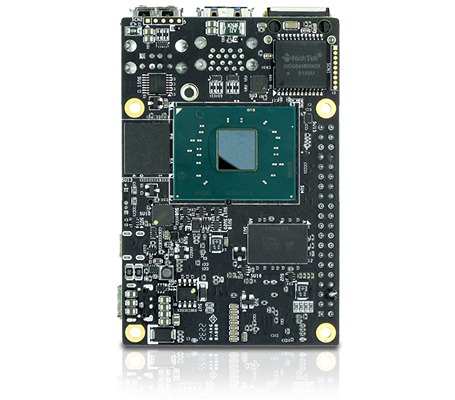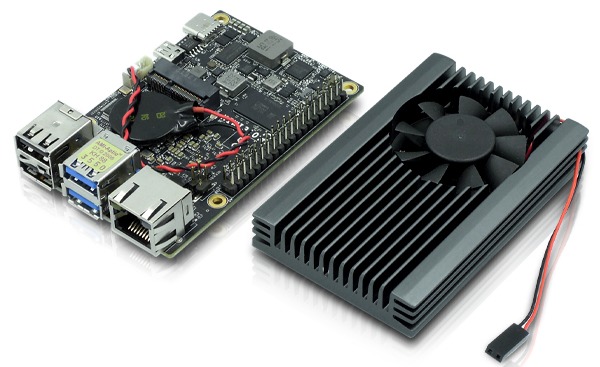
CPU Upgrade
Following market trends and responding to its needs, the KIWI board has taken KIWI310 to the next level by providing a more powerful CPU and a more robust solution for the most demanding applications. While the initial version of the KIWI310 featured the Celeron N3350 processor, it now features an upgraded option in the form of the Celeron J3455, offering users a more powerful computing alternative.
Comparison of Basic Features of CPUs
According to technical data from Intel's official website, processors N3350 and J3455 belong to the Intel Apollo Lake generation, implying a 'Pin to Pin compatible' nature. The main distinction between the two lies in their core configurations. While the N3350 is a dual-core processor, the J3455 features a quad-core configuration. This update also increases core power consumption, with the dual-core N3350 running at 6W and the quad-core J3455 at 10W. Therefore, KIWIboard has redesigned the power circuit to accommodate the differences between 6W and 10W, demonstrating a meticulous commitment to stability.

.png)
Comparison table between J3455 and N3350 (Source: Intel website).
Making a comparison, Intel is positioning the N3350 for mobile devices and the J3455 for desktop computers. Because they target different types of users, there are noticeable distinctions in their designs and specifications.
The J3455 has four CPU cores, a base frequency of 1.5GHz (higher than the N3350's 1.1GHz), and a slightly lower burst frequency than the N3350. The J3455's integrated HD Graphics 500 core also operates at higher frequencies than the N3350's. These changes in core count and clock speed result in different power requirements, with the J3455 needing more power (TDP of 10W compared to the N3350's 6W).
On the other hand, examining the physical appearance of the KIWI310 J3455 version, the board retains its compact 1.8-inch mini size. Still, it now features a physical 4-core processor with significantly higher base and graphics processor frequencies. These upgrades suggest that the device's performance will likely improve based on testing.

KIWI310 with J3455 processor keeping 1.8" form factor
Heatsink for KIWI310 featuring J3455
As the CPU power requirement (TDP) has increased to 10 watts, KIWI310 offers an optional heatsink module equipped with a fan to manage heat effectively. Additionally, Intel CPUs feature a robust temperature protection mechanism that dynamically adjusts the processor speed in response to processing demands and temperature conditions, ensuring system stability. Therefore, the CPU is usually the computer's most reliable and resistant component.
The heatsink's design has a texture that holds particular appeal for enthusiasts who prefer a more stripped-down aesthetic. While this design choice enhances the visual aspect, it also leads to increased manufacturing effort, particularly in CNC machining and edge repair during device assembly using handheld tools. The fan needs an extra 5V power source, and you can directly link it using a 2-pin pitch 2.54mm Dupont Connector to the KIWI310 GPIO 4 and 6 pins. Lastly, the anodized iron gray finish adds a level of sophistication that is on par with, if not superior to, that of mobile handheld devices.

Heatsink for KIWI310 Featuring J3455
Testing Platform Configurations
Two platforms were set up for the test with the following specifications:
-
OS: Windows 10 IOT
-
SBC1:KIWI310 N3350 4G RAM/64G eMMC
-
SBC2:KIWI310 J3455 4G RAM/64G eMMC
-
Power supply: FSP-Group FSP065-A1BR3 65W PD Adapter
-
Monitor:ViewSonic VX2476 24inch
-
Mouse: ASUS ROG STRIX IMPACT II RGB USB
-
Keyboard: ASUS ROG STRIX SCOPE NX TKL 80% RGB
- KIWI310 N3350 CPU-Z information
- KIWI310 J3455 CPU-Z information
KIWI310 CPUs Evaluation
To evaluate the performance of the two CPUs, these three software programs will assist in comparing performance.
- Pass Mark Performance Test V9
- 3D Mark v2.8.6546
- AS SSD Benchmark 2.0.6821.41776
Pass Mark Performance Test V9 Test
This software primarily focuses on comprehensive testing of CPU, 2D graphics, 3D graphics, memory, and disk performance.
Looking at the results in the table below, it's evident that under Turbo mode, the J3455 achieves the highest PassMark Rating, and the default J3455, without Turbo, exhibits performance similar to the Turbo N3350.
Considering the CPU Mark score, this metric primarily assesses the CPU's computational capabilities. It's apparent that a quad-core CPU outperforms a dual-core one, and the score increases as the CPU frequency rises after Turbo mode is engaged.
In terms of Memory and 2D Graphics performance, the CPU's capabilities may have somewhat limited their performance. Consequently, we observe significant differences thanks to the higher frequency and quad-core nature of the CPU. However, both the N3350 and J3455 reach the same limit once the frequency is increased, suggesting that the number of cores doesn't substantially impact these two areas.
Pass Mark Performance Test V9 Result
3D Mark v2.8.6546 Test
This software mainly focuses on heavy 3D graphics testing of the DirectX 12 3D API and is a comprehensive 3D gaming testing indicator specifically for independent graphics cards. The KIWI310 does not have an independent graphics card, so it only uses Intel's built-in HD Graphics as reference data. Therefore, the graphics cores of N3350 and J3455 are not competent and should only be used as a reference.
3D Mark v2.8.6546 Result
AS SSD Benchmark 2.0.6821.41776 Test
This software mainly focuses on comprehensive read and write performance testing of storage devices, covering the scope of system operation and user read and write, such as large file read and write, 4K random read and write, 4K-64Thrd simultaneous 64-thread 4K random read and write, Acc. time search time, and the final comprehensive score.
Regarding the Read or Write tests, the CPU has minimal impact on the results. Consequently, users who prioritize read and write performance can comfortably opt for either version of the KIWI310 CPU without significant differences.
AS SSD Benchmark 2.0.6821.41776 Read Result
AS SSD Benchmark 2.0.6821.41776 Write Result
Why KIWIboard Solutions?
Based on the comprehensive test results, the standard KIWI310 N3350 processor is a reliable choice for most usage scenarios. For those who seek even greater CPU capabilities, the upgraded KIWI310 J3455 version offers quad-core processing prowess and enhanced overall performance. This empowers you with expanded possibilities when making selections and evaluations.
The versatility of KIWIboards provides a cost-effective and expandable solution that leaves room for future enhancements!
About KIWIboard



